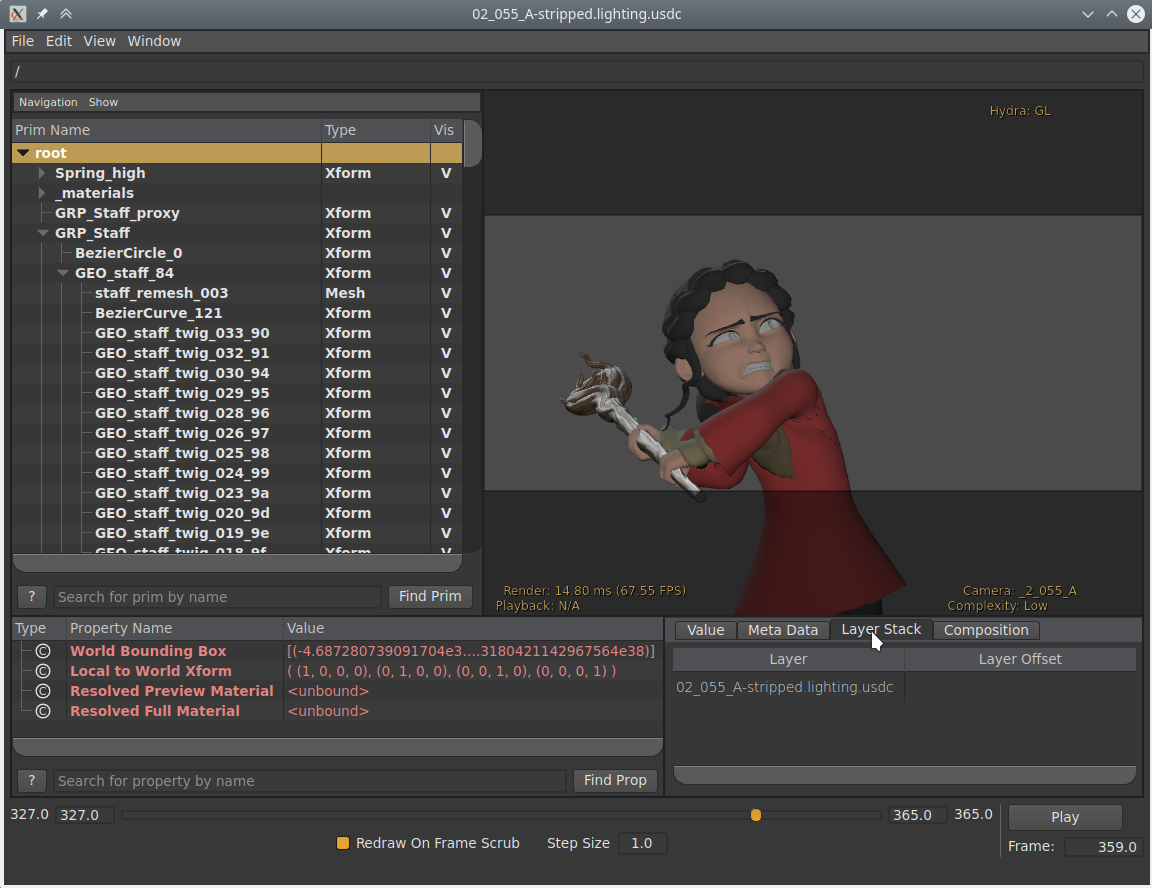Universal Scene Description¶
Universal Scene Description (USD) files can contain complex layering, overriding, and references to other files. Blender's USD Exporter takes a much simpler approach. When exporting, all visible, supported objects in the scene are exported, optionally limited by their selection state. Blender does not (yet) support exporting invisible objects, USD layers, variants, skeletal animation, etc.
The following objects can be exported to USD:
Meshes (of different kinds, see below).
Cameras (perspective cameras only at the moment, not orthogonal ones).
Light (all types except area lights).
Hair (exported as curves, and limited to parent strands).
When exporting an animation, the final, evaluated mesh is written to USD. This means that the following meshes can be exported:
Static meshes.
Deforming meshes; here the topology of the mesh does not change, but the locations of the vertices change over time. Examples are animated characters or bouncing (but not cracking) objects.
Arbitrarily animated meshes; here the topology does change. An example is the result of a fluid simulation, where splashes of fluid can break off the main body.
Metaballs are exported as animated meshes.
Export Options¶
The following options are available when exporting to USD:
- Selection Only
When checked, only selected objects are exported. Instanced objects, for example collections that are instanced in the scene, are considered 'selected' when their instancer is selected.
- Visible Only
Only exports objects that are not hidden. Invisible parents of exported objects are exported as empty transforms.
- Animation(アニメーション)
When checked, the entire scene frame range is exported. When unchecked, only the current scene frame is exported.
- Hair(ヘアー)
When checked, parent hair strands are exported as a curve system. Hair strand colors are not exported.
- UV Maps(UVマップ)
When checked, includes UV coordinates for exported meshes. The name of the UV map in USD is the same as the name in Blender. In USD the default name is
stwhereas in Blender the default name isUVMap. To export to the standard UV map namest, rename the UV map in Blender tost.- Normals(法線、ノーマル)
When checked, includes normals for exported meshes. This includes custom loop normals.
- Materials(マテリアル)
When checked, exports the viewport materials of meshes. When a mesh has multiple materials assigned, a geometry subset is created for each material.
The first material (if any) is always applied to the mesh itself as well (regardless of the existence of geometry subsets), because the Hydra viewport does not support materials on subsets. See USD issue #542 for more information.
- Use Settings for
Determines the whether to use Viewport or Render visibility of collection, modifiers, or any other property that can be set for both the Viewport and Render.
Experimental(実験的)¶
- Instancing(インスタンス化)
As this is an experimental option. When unchecked, duplicated objects are exported as real objects, so a particle system with 100 particles that is displayed with 100 meshes will have 100 individual meshes in the exported file. When checked, duplicated objects are exported as a reference to the original object. If the original object is not part of the export, the first duplicate is exported as real object and used as reference.
制限¶
- Single-sided and Double-sided Meshes
USD seems to support neither per-material nor per-face-group double-sidedness, so Blender uses the flag from the first material to mark the entire mesh as single/double-sided. If there is no material it defaults to double-sided.
- Mesh Normals
The mesh subdivision scheme in USD is 'Catmull-Clark' by default, but Blender uses 'None' instead, indicating that a polygonal mesh is exported. This is necessary for USD to understand the custom normals; otherwise the mesh is always rendered smooth.
- Vertex Velocities
Currently only fluid simulations (not meshes in general) have explicit vertex velocities. This is the most important case for exporting velocities, though, as the baked mesh changes topology all the time, and thus computing the velocities at import time in a post-processing step is hard.
- Coordinate System Orientation
Blender uses the Z axis as up axis. Since USD supports both Y up and Z up, the USD files written by Blender always use Z up.
- Materials(マテリアル)
Very simple versions of the materials are exported, using only the Viewport Display(ビューポート表示) color, metallic, and roughness.
When there are multiple materials, the mesh faces are stored as geometry subset and each material is assigned to the appropriate subset. If there is only one material this is skipped. Note that the geometry subsets are not time-sampled, so it may break when an animated mesh changes topology.
- Hair(ヘアー)
Only the parent strands are exported, and only with a constant color. No UV coordinates, and no information about the normals.
- Camera(カメラ)
Only perspective cameras are exported.
- Lights(照明)
USD does not directly support spot lights, so those are not exported.
- Particles
Particles are only written when they are alive, which means that they are always visible. There is currently no code that deals with marking them as invisible outside their lifespan.
Objects instanced by particle system are exported by suffixing the object name with the particle's persistent ID, giving each particle transform a unique name.
- Instancing/Referencing
This is still an experimental feature that can be enabled when exporting to USD. When enabled, instanced object meshes are written to USD as references to the original mesh. The first copy of the mesh is written for real, and the following copies are referencing the first. Which mesh is considered 'the first' is chosen more or less arbitrarily.
